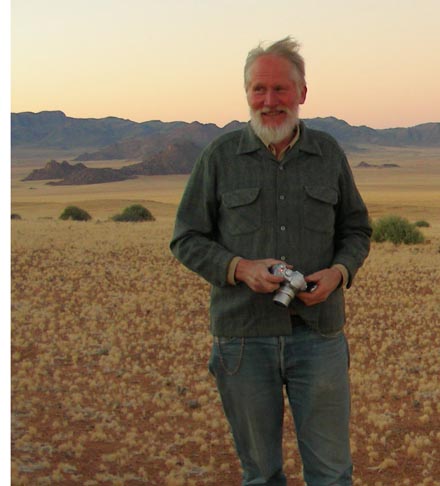
The Department of Ornithology and Mammalogy recently conducted field work in Namibia. We left San Francisco together on 29 May, 2007, and we returned home on 5 July.
Our cast of characters included:

Galen Rathbun is a Research Associate in Birds and Mammals, and is an expert on sengi behavior and natural history. He has an excellent website on sengis and he has been visiting and working in Africa since he was an undergraduate student at Humboldt State Univeristy in northern California. Galen is also a co-author of an in-press paper that describes a new species of Rhynchocyon, or giant elephant-shrew, and has authored dozens of other papers on elephant shrews. If you are interested in any of these, please write us and we can send you pdf copies of those papers.

And me, I'm Jack Dumbacher, curator of Birds and Mammals at the California Academy of Sciences. Birds are my primary research focus, however I dabbled in mammals for this project.
My wife, Tiffany, also joined us. She is a fine artist and sometimes volunteers in our department. And although she has only prepared about 25 museum specimens, she does a beautiful job and was an invaluable help in the field. You can see some of Tiffany's paintings at this website.
The purpose of our trip was two-fold. First, we wanted to study the round-eared sengi, or Macroscelides proboscideus. There is a question about how many species of Macroscelides there are, and we had identified in area in the Namib Desert where the two forms appear to come together, somewhere around Gorrasis Farm in the Malthohe district. You can read more about this issue by clicking here.
Secondly, Galen collected some elephant shrews in the north that appeared different from the typical Elephantulus intufi, or bushveld elephant shrew. We went up to Windpoort Farm, owned by Galen's friend and colleague Tim Osborne, to study these Elephantulus and try to collect some specimens for preliminary analyses. Thus, our work focused on the the taxonomy and systematics of Namibian elephant shrews, or sengis.
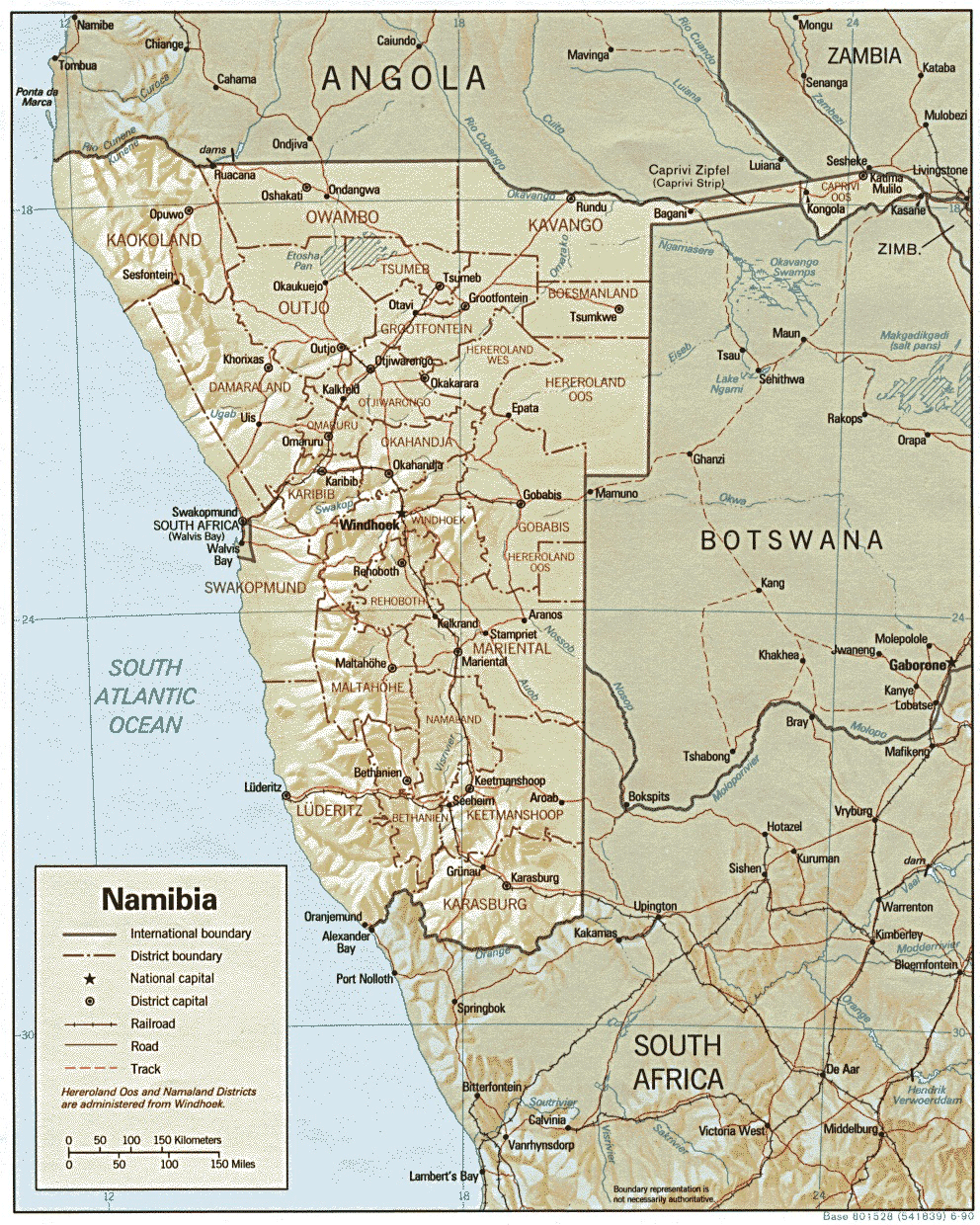
In case you didn't know, Namibia is on the west coast of Africa, just north of South Africa, west of Botswana, and south of Angola. You can click here or on the map above for a larger scale image.
You need to know that in Namibia, most of the localities cited in natural history resources are "farms" or distinct clumps of real-estate similar to ranches in the United States. Many of these farms comprise several thousand hectares each, and are huge tracts of land, often owned by a single person or family. Specimens in museums often cite only the farm name and the district, and most of the names I give below reference various farms we visited. Below are some of our natural history and journal notes from the trip, annotated with photos.
31 May 2007 – We arrived in Windhoek, extremely tired from our flights. Our Virgin Atlantic flight was delayed from Heathrow to Johannesburg, but because of Galen’s vigilance and perseverance, we were put on a South African Airways flight and managed to make our connection from J’burg to Windhoek. Herbert Hester from Kalahari Car hire picked us up and set us up with two “bakkies” with a rooftop tent, two stoves, a table, and lots of other gear. We then drove to meet with Mike Griffin, a colleague and friend of Galen’s who is presently works as a biologist for the Ministry of Environment and Tourism. We stayed with Mike in his visitor’s flat above his house while we purchased field gear, food, and other supplies. Mike helped advise us – he probably knows more about Namibian small mammals and reptiles than just about anyone (with the possible exception of Nils Coetzee, a retired biologist now living in Swakopmund, a few hours to the west of Windhoek.) We enjoyed seeing Windhoek and trying some of the nice dining places.
3 June 2007 - We had all of our gear packed last night and ready for the
trip, and this morning we headed out early for the Namib Rand. The landscape
is incredibly
expansive, and the desert is vast and open. Every day has been sunny and
cool, which is what we can expect for the entire trip. On our way out of
Windhoek,
we saw troops of baboons along the road, and we stopped at several little
roadside picnic tables for snacks and for rests. After only a couple hours,
we were
off the paved roads and on dirt roads, heading for Maltahohe
. 
The Road From Maltahohe to the Namib Desert
The roads are
still quite smooth and we are able to go 90-100km/hr comfortably, but you don’t
want to overestimate your ability to grip the road – the car does slip
and slide around a bit like driving in the snow.
The scenery is amazing here – by early afternoon we were dropping off
the
escarpment and into the Namib desert.
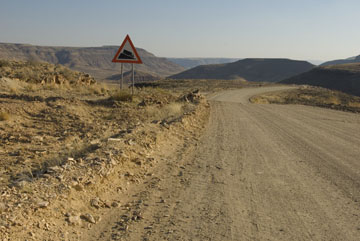
The scenery and mountains were spectacular, and some of the farms were beautiful clusters of houses surrounded by bore-hole (well-water) oases in the dry desert. We approached the sand and gravel plains of the Namib as the sun was sinking, and we saw a gemsbok along the road, a jackal, bat-eared fox, and lots of other game inside the park. We stopped at Keerweder Farm, where Danica (the research warden) and her husband Nils live. Here we picked up the keys, and Danica took us back to the research house at Toekoms Farm where we will be staying while we work in the NamibRand Nature Reserve. It is a brilliant consortium of farm owners who have turned their efforts toward tourism and nature conservation, and it is a stunning place to conduct research!
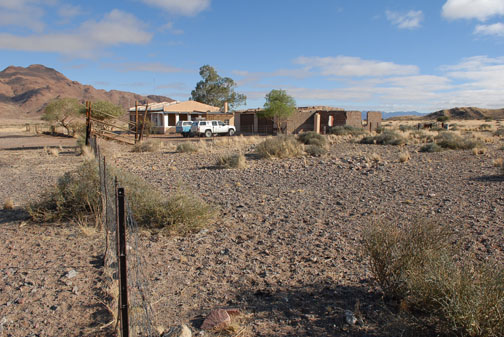
Toekoms Farm with our Bakkies parked by the farmhouse.
4 June 2007 – NamibRand Nature Reserve. We were up fairly early. It is
cold here at night – our max/min thermometer suggests that it was near
freezing last night, and it feels like it. Luckily, the solar water heater
works quite well, so a shower and shave with a little hot water was not too
much to
ask. We spent the morning driving around looking for the gravel plains where
the round-eared elephant shrew (Macroscelides proboscideus)
lives.
Based upon work done in the 1960’s, there is one species of Macroscelides currently
recognized. However, based upon Galen’s work with them, there
are two clear forms – a light pinkish form that occurs in the Namib Desert,
and a darker form that occurs in South Africa and in the higher elevations
above the Namib Desert in Namibia. Interestingly, the two forms should come
together
here near Keerweder farm. We are here to try to study the Macroscelides and
try to assess whether these two forms are actually two different species. We
will
do this by collecting DNA samples and museum specimens of Macroscelides.
We will use genetics to assess how distinct each form is from the other and
look for the genetic signature of genetic mixing of the two forms.
After several hours of driving around, we were able to find gravel plains like
those normally preferred by Macroscelides, however, we were unable
to find any sign that the elephant shrews are here. Finally in the afternoon,
we set
up traplines
in several different habitats – some bushveld over gravel plains, and
some open gravel plains – hoping that we will be able to catch a few
elephant shrews in our traps. The sun was setting as we placed our last traps
on these expansive desert plains.
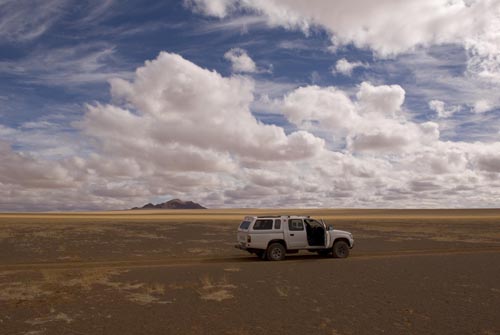
This is the sort of gravel plain on which we expected to find the Macroscelides (round-eared sengi). This is one of our traplines just south-east of Keerweder Farm.

Here is the last trapline that we set in the evening, as the sun was going down.you can see a trap just to the right of the road in the photo.
5 June 2007
We got up and checked our traps, and we had huge trap success, but no sengis. Most of what we caught were small gerbils, and we released as many as we could. We pulled the traps from the first trapline (Keerweder East), as there were too many gerbils and no sign at all of sengis.
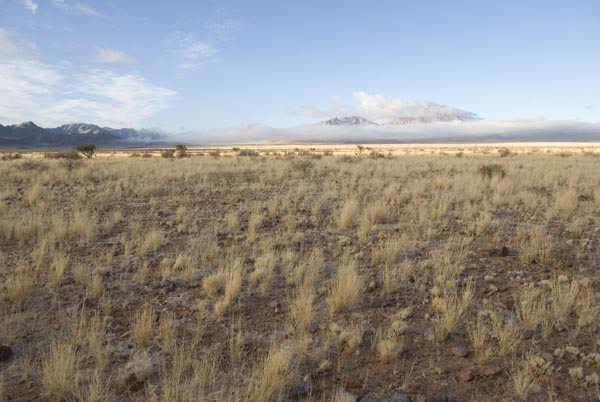
Our first trapline, Keerweder East, had this rocky-sandy substrate, and produced mostly gerbils and a couple mice.
One of the traplines had obviously been hassled by a bat-eared fox that moved traps and urinated on several more. We also removed these traps, as we were confident that the foxes would continue to hassle or break the traps and/or injure the small mammals that we trapped.
We shifted some traps and spent some more time looking for sengis in other places. In the end, we decided to put more effort into the other traplines, and give them another day.
We also chatted with Danica and Nils, who talked with a couple of their field hands and some of them had seen sengis and had ideas of where we should look for them. All of their ideas pointed to rock outcroppings, where we were likely to catch Elephantulus rupestris, and not likely Macroscelides. Nonetheless, we did move a few traps to the rock outcrop near the Keerveder Farm to see which sengi species was present.
Back at Toekum Farm, we also caught a small mouse - Aethomys - in a tree, and more gerbils around the house. We set up a small corral with chicken wire for photographing sengis, and we prepared to also photograph an assortment of the rodents that we trap. We also checked out this Social Weaver birdnest, where hundreds of these birds nest communally and fly in and out as a flock with a huge swooshing sound.
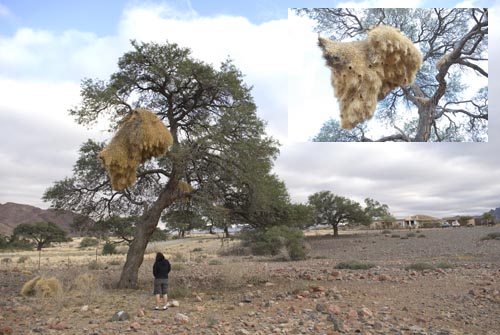
6 June 2007
We caught our first sengis today - the western rock sengi, or Elephantulus rupestris - on the rock kopi near Keerveder Farm. Although it wasn't the species we were looking for, it was still nice to have a couple individuals to study and photograph. They are super cute, and it gave us an opportunity to try out our little sengi corral.
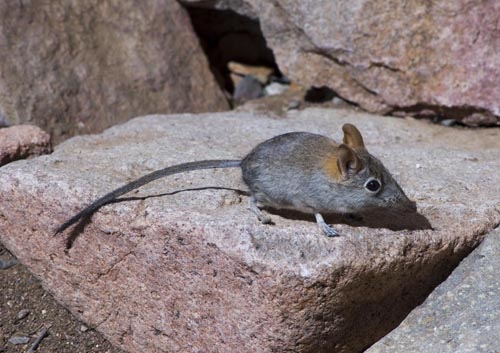
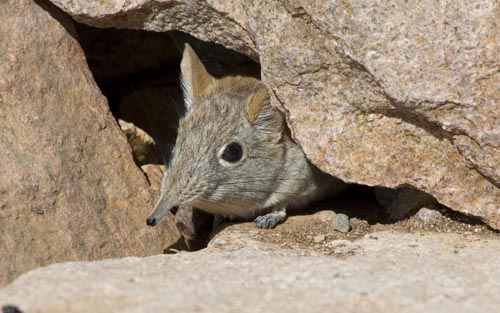
Here are a couple views of the western rock sengi from Keerveder. Note the large ears, dark pelage, and red behind the ears. You can also see the long tail with the long dark hairs on the tip. I personally find these species difficult to tell apart, but you can use these characteristics fairly reliably in the field. They also live almost exclusively on rocks, and they are superb at bouncing from rock to rock and crawling into rocky holes. The long nose is constantly sniffing and moving around, hence the name elephant shrew. Actually, they are not particularly closely related to elephants or shrews, but they are in their own family, Macroscelididae, found only in Africa. Their posture and movement is more reminiscent of an antelope or tiny klipspringer than it is like a rodent, even though their small size may remind you of a mouse...
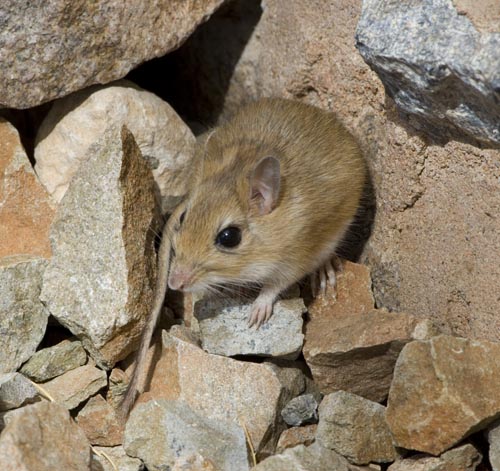
We did also catch several rodent species, including this Gerbillurus paeba, or pygmy gerbil. In the evening, we gave a lecture at Toekum Farm for Danica and anyone else in the reserve who was interested in coming. Several guides and researchers from nearby farms did attend, and it was nice meeting them.
7 June 2007
We are starting to get a handle on some of the confusing rodent species in the area. Here is the brush-tailed hairy-footed gerbil, or Gerbillurus vallinus.
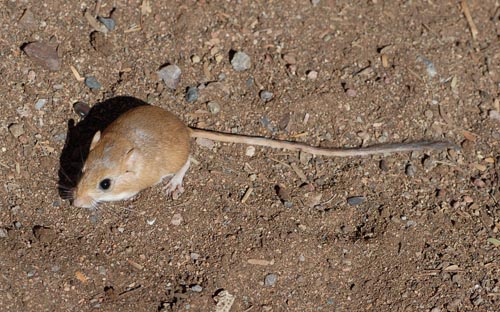
Today we closed up our traps. We had found no promising sign of Macroscelides in the area, and we were even unsure about its habitat. Other folks hadn't seen them either - only the western rock sengi - so we decided to move our trapping to Zwartmodder Farm - a nearby farm on which Macroscelides had been caught a couple decades ago. We hoped to catch some at Zwartmodder and learn a little more about how and where to find them.
In the evening, we drove out to a nearby kopi in the dunes for a "sundowner."
We packed some wine, cheese, crackers, our cameras, and we also stopped by
to visit some giraffes that just moved into the area. 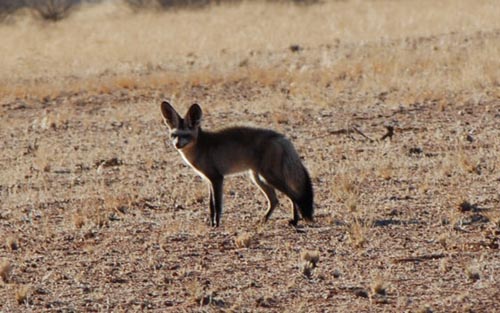
We also saw bat-eared fox,

gemsbok or oryx,
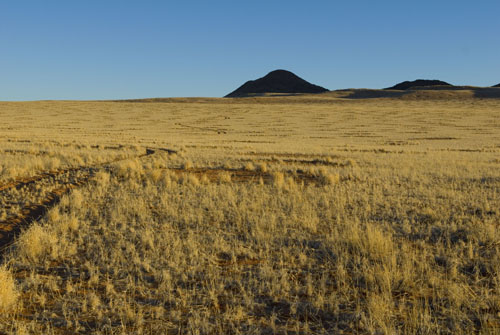
and some truly amazing sunset views in the NamibRand Nature Reserve!!!
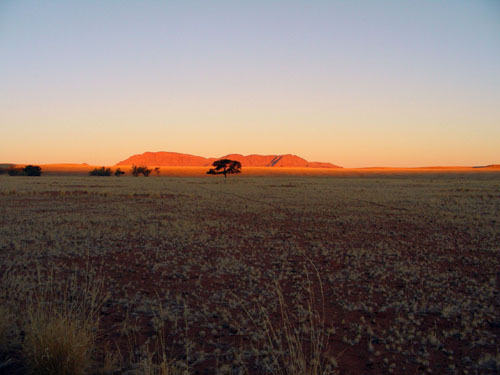
8 June 2007
Today we packed up early, drove to Betta camp for gasoline, and then headed back north toward Zwartmodder Farm on the edge of the escarpment. The farm is spectacularly beautiful, and very huge. The current owners, Susan and Anton Horn, own both the Zwartmodder Farm and the adjacent Omkyk Farm, so it was difficult for us to figure out exactly where the previous Macroscelides had been collected. Nonetheless, even as we drove in to their farmhouse, we saw an Elephantulus scurry across the road. We got out, looked around, and noticed dozens of runways and feces of sengis. Sengis are actually tiny ant-eaters, so it is easy to tell if feces are from sengis or from rodents, as the elephant shrew dung is just losely packed ant exoskeletons. Rodent dung is usually tightly packed plant matter. So we knew we had sengis, but we weren't sure which species. So we worked until well after dark getting up six different traplines in a variety of habitats, and then headed back to the farm.
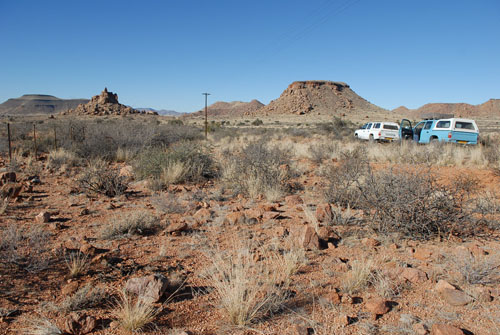
The landscape on Omkyk Farm, near the border with Zwartmodder, is rocky bushveld with numerous rock kopis. These rocks are quite old, and geologists have also visited this farm to study the rock formations along the upper escarpment.
Although Susan and Anton had other guests, they very generously invited us in and gave us a room and beds to sleep in. Susan cooked a wonderful dinner, and we sat around the dinner table with Anton, Susan, and their other guests and talked about biology and geology and politics and then we all turned in and got a fabulous nights sleep in their cozy farmhouse.
9 June 2007
We were out early checking traps, and we collected a variety of rodents and another sengi species, Elephantulus intufi, the bushveld sengi.
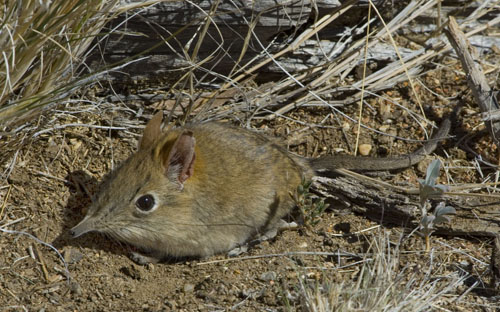
Elephantulus intufi, the bushveld sengi. Note the large ears and the white eyering, and of course the long nose of the elephant shrews.
These appeared to be the common species that were responsible for the runways and feces that we detected yesterday. We also caught several gerbil species. Because there were no Macroscelides (or even any clear sign), we pulled our traps and split up. I worked on taking photos and working with the specimens, Tiffany hung out with Susan and the two of them went for a tour of the farm, and Galen drove around looking for alternative suitable habitats for trapping Macroscelides. Galen did find some trap locations down on the gravel/sandy plains, but we had little hope that we would catch any Macroscelides there.
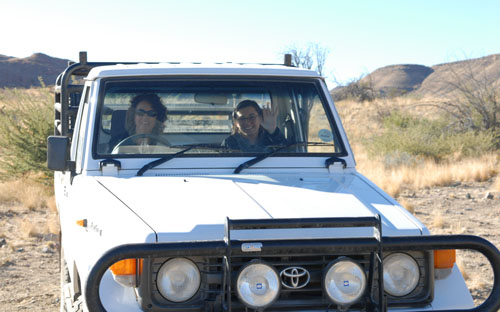
Susan and Tiffany take a tour of the Zwartmodder Farm - the farm is beautiful and amazingly well kept by Anton and Susan.
10 June 2007
We got up early, and it was cold - the water in our pipes had frozen. Galen had put out over 100 traps in three long lines, and the second set of traps produced the Macroscelides sengis (the round-eared sengi) that we were looking for. These little guys are super cute - just a little egg shaped body and head with their nose sticking out of one end and their tail on the other end. The form found here in Zwartmodder appears to be the darker form that normally occurs above the escarpment and on the darker soils. This is interesting since Zwartmodder is off the escarpment and on the flat plains near the main road and there are continuous gravel plains to the Namib Desert.
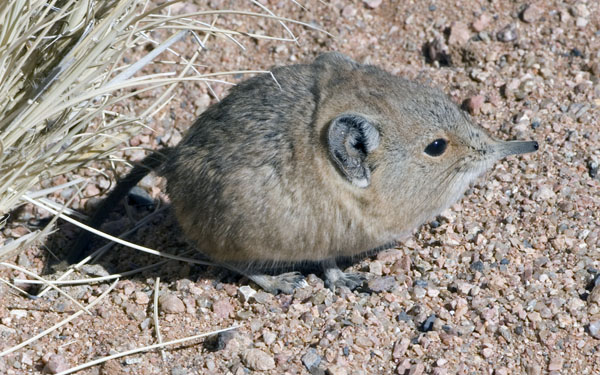
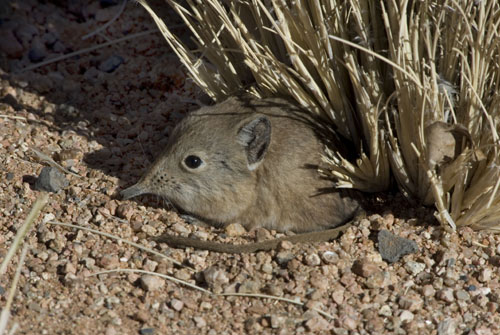
The trapline was sandy soil plain, but the substrate was firm underfoot. The successful traps were placed at these old fenceposts on the level ground.
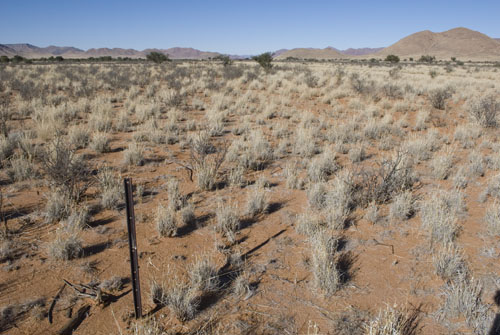
We caught enough in one morning for our studies, and we worked all day to take photos and prepare DNA samples and museum specimens. We had a final fancy dinner with Susan and Anton and we prepared to move on to Gorrasis Farm the next day.
June 11 2007
We pulled away from Zwartmodder in the morning, and headed back down the plains toward the sandier Namib Desert and toward Gorrasis Farm. This farm is tucked in a little valley on the western slopes of Horseshoe Mountain. We drove most of the morning, and stopped in Tok Tokkie to say hello to friends of Galen's, Viktoria Keding who runs the NaDEET center and her husband, Senior Ranger Andreas Keding. (More on NaDEET later...) They gave us directions for driving over the red sand dunes and out to the Gorrasis house, and then we were on our way again. The drive was beautiful through the low gravel plains rimmed with bare stone mountains jutting up from the red sandy plains. It is a geologists dream to see so many rocks exposed.
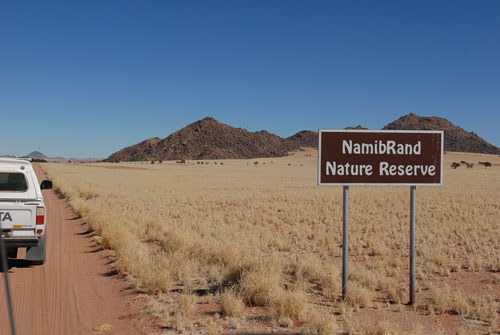
The country is quite different from that of Zwartmodder, but both places had ample gravel/sandy plain for the round-eared sengis.

We saw multiple large herds of gemsbok and springbok on the drive in, and throughout our stay in the area. We set ourselves up at Gorrasis, and then Galen and I set traps out in the gravel plain while Tiffany got the camp organized.
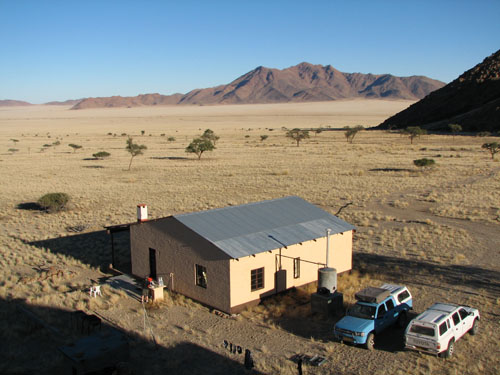
The Gorrasis house was pretty spectacular, and it was very generous of the owner to allow us to use it. The view from the veranda is amazing, and we often heard or saw herds of antelope and oryx feeding on the grasses nearby.
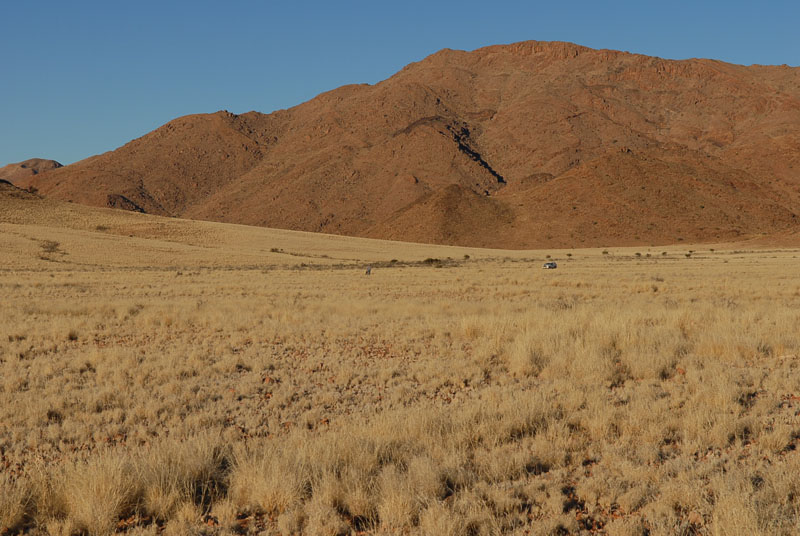
This is one of the traplines we set that night, and these traps were especially productive. You can see that it is very flat, sandy-gravelly soils, but there are some small fist-sized rocks on the surface and some grass for cover. Although we caught a couple gerbils, we mostly caught Macroscelides. By the time we set up all of our traps, the sun was going down. On the drive back, we saw multiple aardwolf moving along the plain, and we stopped to watch the colors spread over the horizon.
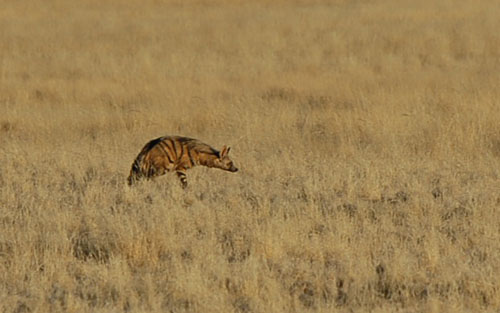
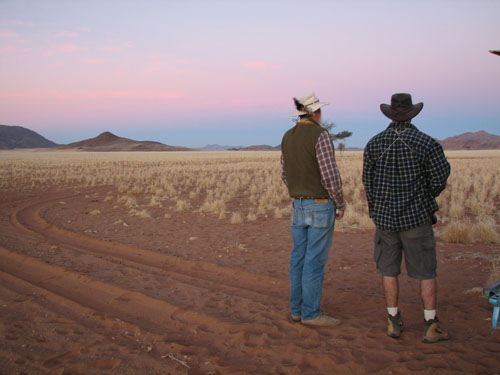
12 June 2007
When we ran our traps, we had more round-eared sengis than anything else - it appeared from our sampling that Macroscelides was the most common small mammal on the plain. Within one morning's trapping we had enough samples for our work. We pulled our traps, but we did also set some traps in the bouldery hills behind the house in an attempt to capture some Petromyscus and additional western rock sengis. Galen also had a friend who is studying hyraxes, so we went up into the hills to try to catch a hyrax. They are always on the lookout, so although we saw plenty of them, trying to actually catch one was out of the question, but hiking through the rocks and up into the wash was interesting and we encountered some unusual plants and great views.
We spent a bit of time in the "sengi corral" taking photos of the round-eared elephant shrews as well as a couple mice we trapped.

And here are some of the best shots of the round-eared elephant shrew:
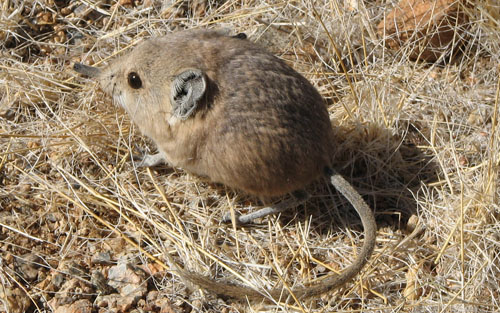
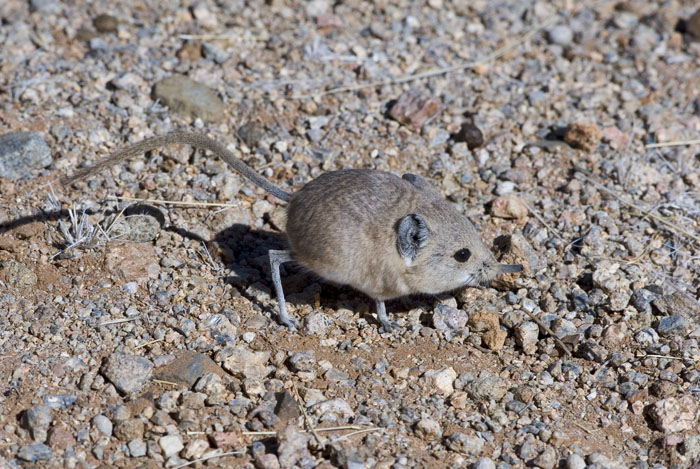
We were just finishing our work when the sun started to dip, so we drove across the valley for a "sundowner" glass of wine and to watch the sun disappear behind the mountains.
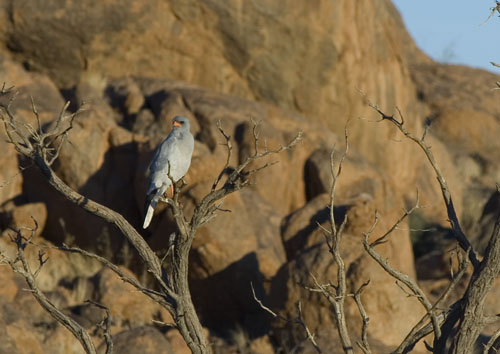
We passed a Pale-chanting Goshawk along the way hunting from a treetop.

The evening sky is incredible in Namibia...
14 June 2007 -
We packed up our things in Gorrasis, and we were heading north to the coast and to Swakopmund. We expected that it would be a long day of driving past Sesriem (where the big red dunes are) and up through the Namib Naukluft National Park. We started by driving up over the dunes, and taking a few minutes to check out the dunes and take some photos.
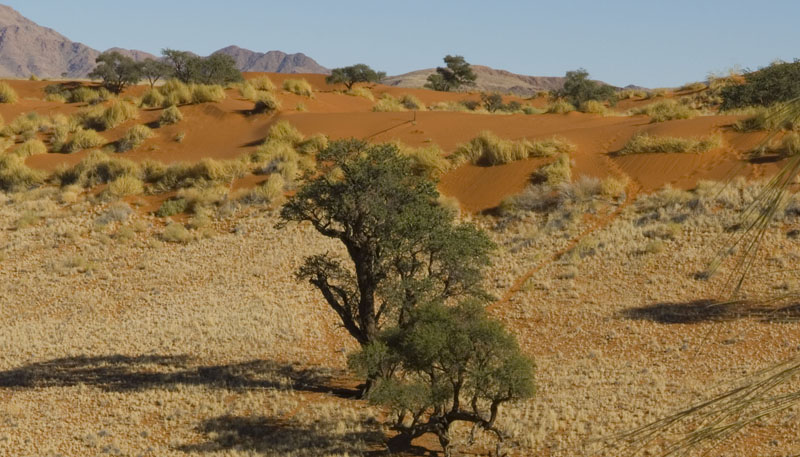

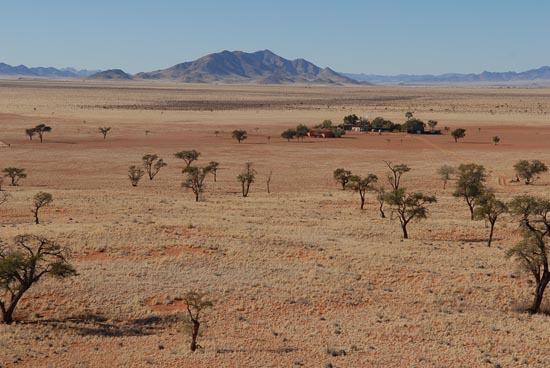
From the dunes, we could see TokTokkie Farm, where they have walking/hiking tours of the NamibRand and the home of the NaDEET, the Namib Desert Environmental Education Trust. We took a short tour of their camp where kids learn to live in the desert with minimal needs and minimal impact.
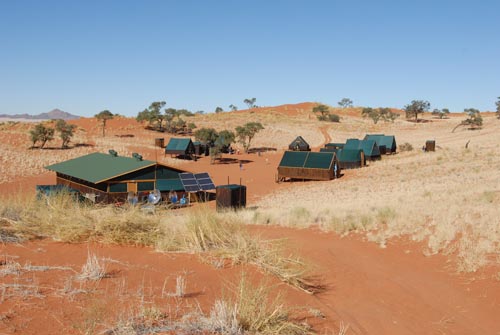
NaDEET desert camp.
And then we were back on the road north to Swakopmund. The desert scenery was amazing - stark and relentless. We passed along the Kuiseb river and the famous gramadoelas - a broken barren landscape with a confusing tangle of hills and washes, and then we continued north west across the gravel plains and into the dunes of Walvis Baai and Swakopmund. It took all day to make the drive north on dirt roads, and even then we arrived at dusk, so we only rarely stopped and took even fewer photos.
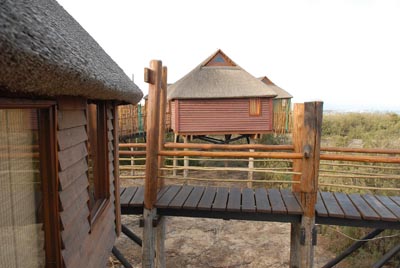
We spent the night with Galen's friend Danie Holloway, who runs this stunning hotel right IN the Swakop River.
June 15th - Today we visited with Nils Coetzee, a retired mammalogist living in Swakopmund. We then drove to Erongo Wilderness Lodge to visit Galen's friends Roger and Lindy, who manage the lodge. Galen has done quite a bit of research here in Erongo, so we visited to break up the drive north and to have a little break since we had been working practically nonstop. Erongo is beautiful - with huge rock formations and great views of wildlife, including baboons, rock hyrax, grey hornbills, and many others.
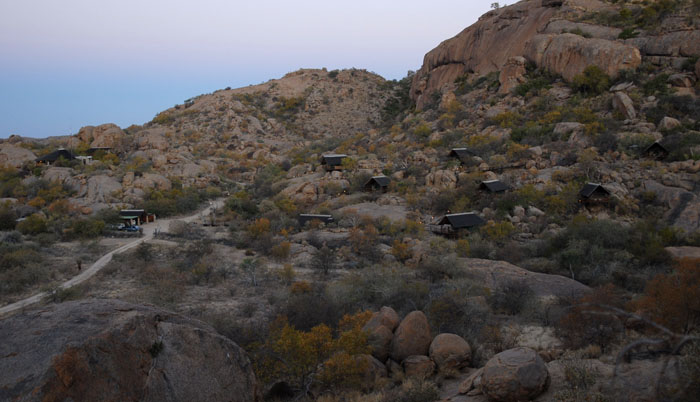
The cabins at Erongo are nestled in the granite boulders for a spectacular view of the sunset and for great wildlife viewing. Although we saw alot of wildlife here during our short stay, I only photographed a couple...
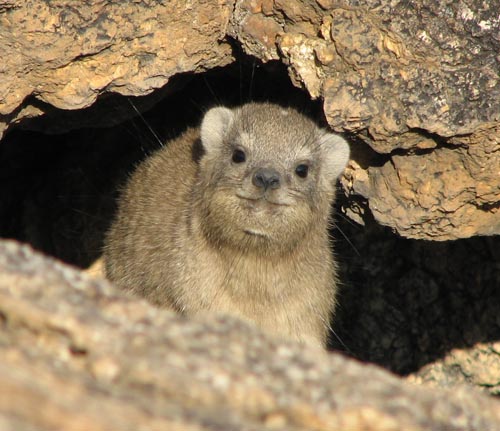
Here is the rock hyrax. They're common at Erongo and are easy to photograph.
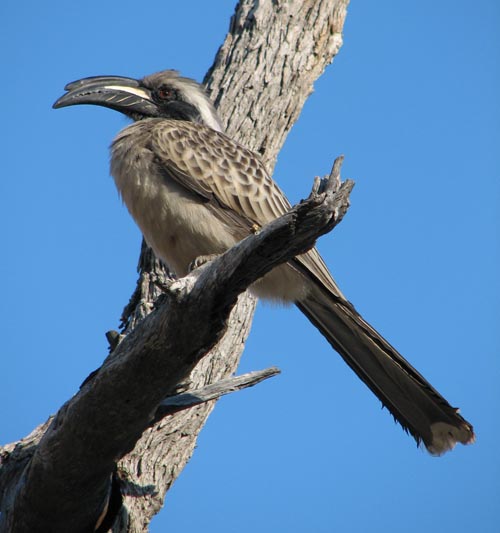
Grey Hornbill, Tokus nasutus.
17 June 2007 - We left Erongo in the morning, and started on our long drive north toward Windpoort Farm, owned by friends of Galen's and great naturalists, Tim and Laurel Osborne. They all went to school together at Humboldt State University, and Tim and Laurel recently moved to Namibia, bought at farm, and have a beautiful lodge named Tandala Ridge. Tim and Laurel also run a small campground and picnic area on the farm. They host many other naturalists, bird ringers (bird banders for Americans - although this is a popular hobby for Europeans) and hunters. Tim recently published a book on the wildlife of Etosha National Park, which is only a few miles north of Windpoort farm, and he and Laurel have done a bit of research in the park.
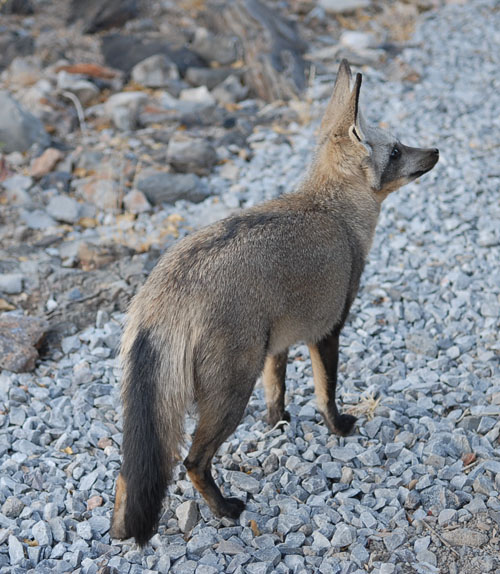
The Osborne's also had a "pet" bat-eared fox that came and ate scraps of meat at Tandala Ridge,

and an African Wildcat that did the same. This is a full-blooded wildcat, although it isn't so wild anymore...
On Tim's farm, the form of bushveld sengi, Elephantulus intufi differs slightly from what Galen is used to at Erongo, and differs somewhat from the forms we trapped on Zwartmodder Farm. Galen suspected that it may be a new species or subspecies, so we camped out for a few days at Windpoort while trapping in nearby areas on that farm and on two other nearby farms.
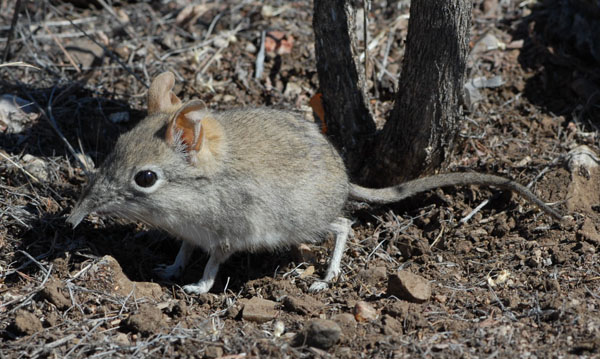
The Elephantulus from Windpoort...

And another group of friends that visited us at Tim's campsite.
The male ostrich could be a little territorial, and it periodically performed its display dance inviting us to join its harem.

Our house in the desert...
We were very successful trapping in the area, as Elephantulus was common here.
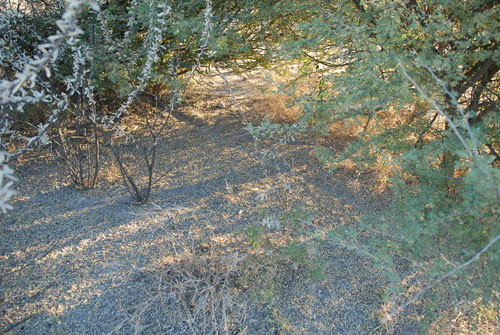
Here you can see a sengi runway at right angle to the shadows (running from top left to bottom right). These are shallow depressions in the chalky dust that run from the base of one tree to another, and are basically sengi tracks. They tend to be straighter than the meandering rodent runs, and they tend to be peppered with their diagnostic feces, composed only of digested ant exoskeletons. Thus, once you know what to look for, it is fairly easy to catch them. They don't dig burrows themselves, but they tend to roost at night nestled under a tree, much as an antelope would. When frightened, they do sometimes dive into a nearby hole in the ground, but only when really pressed an unable to escape under other more suitable cover.
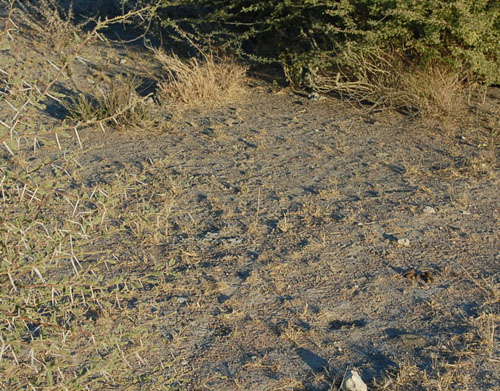
Here is another sengi runway.
25 June 2007 - After several days of work at Windpoort, we took three days in Etosha National Park to see more animals, take photos, and have a little holiday before returning to Windhoek and our work at the museum. Here are some photos from Etosha...
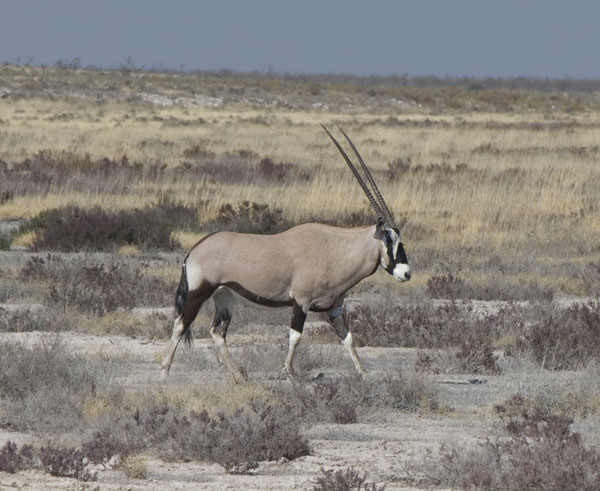
Gemsbok
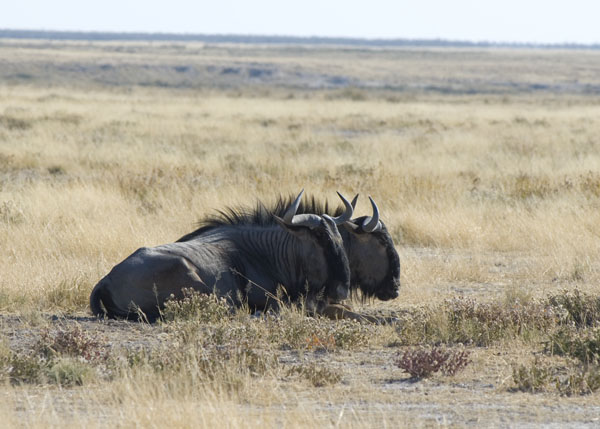
Wildebeest
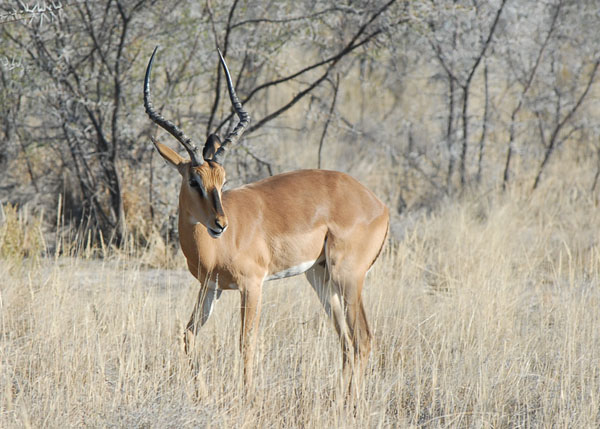
Black-faced Impala
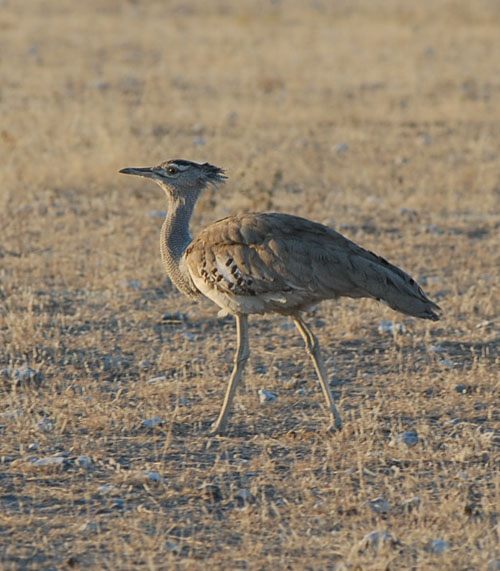
Kori Bustard
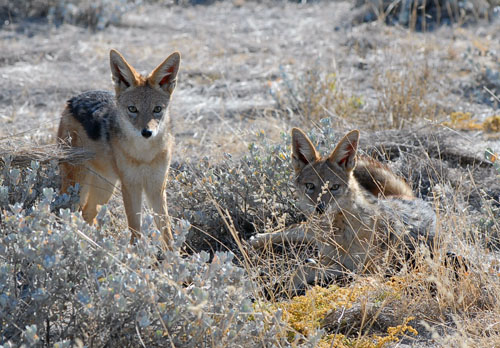
Jackals
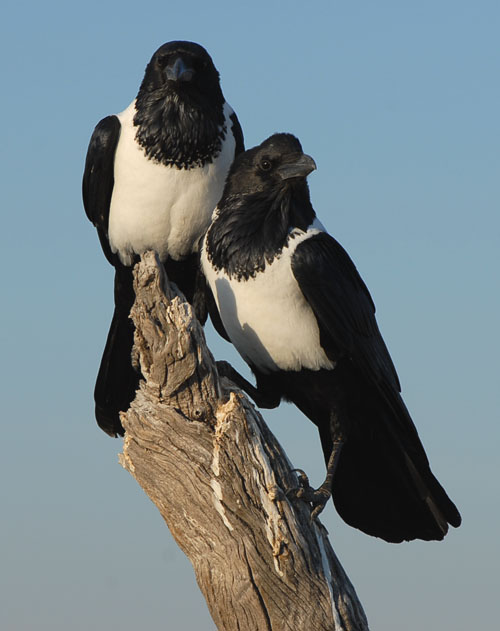
Pied Crows
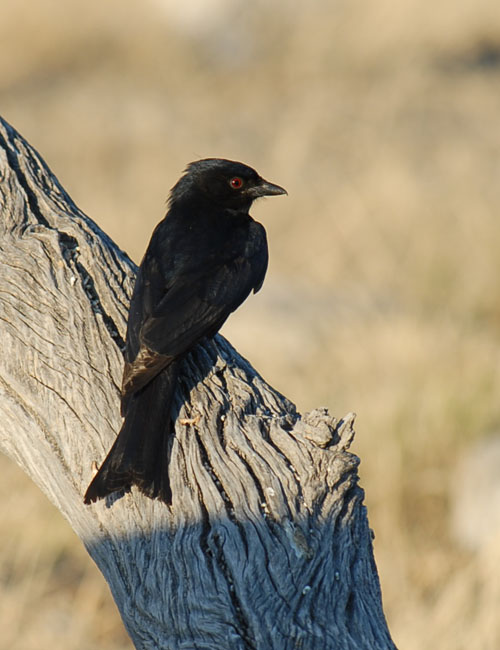
Forked-tailed Drongo (Dicrurus adsimilis) - this species is especially interesting to me, as some early papers by the English Naturalist, C. F. M. Swynnerton, described these as poisonous to cats. They seem to fly around without being hassled or attacked, and Swynnerton also claimed that the Black Flycatcher (Melaenornis pammelaina) mimics them.

Greater Kestrel
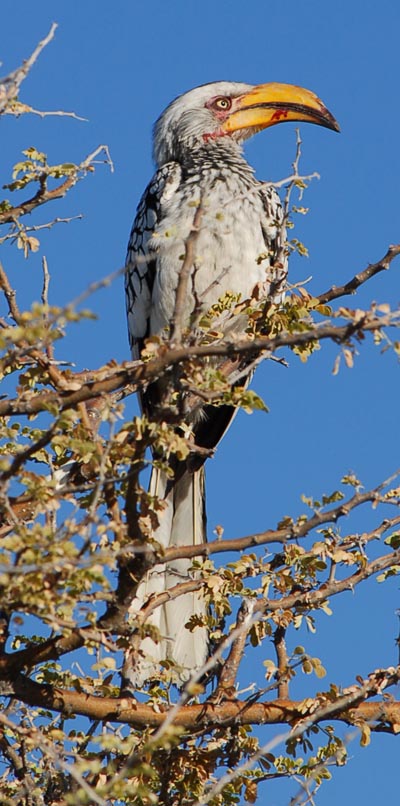
Yellow-Billed Hornbill
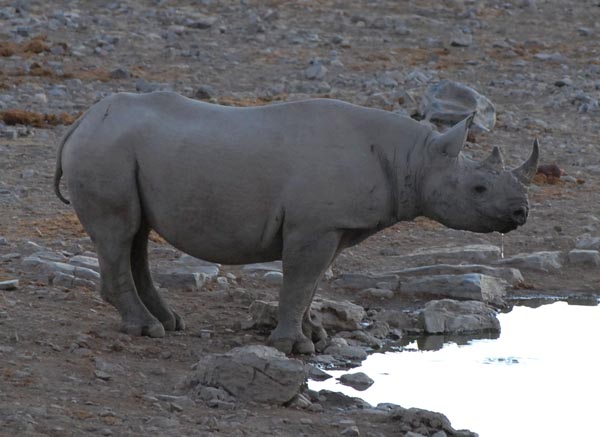
Black Rhino
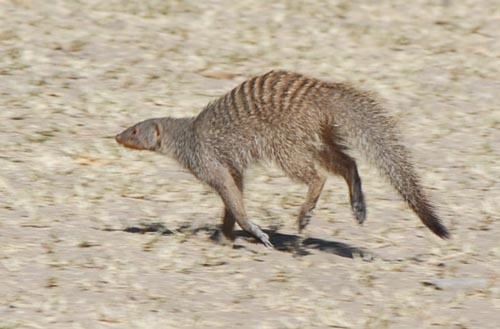
Banded Mongoose

Baby Elephant
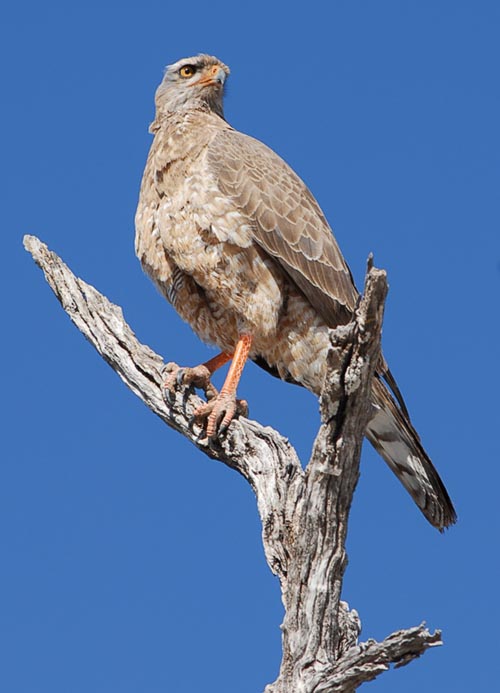
Immature Pale Chanting Goshawk
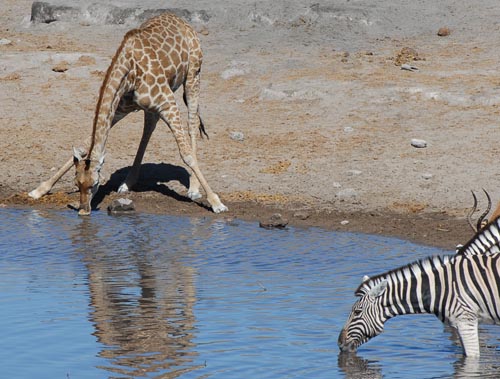
Zebra and giraffe at a waterhole.
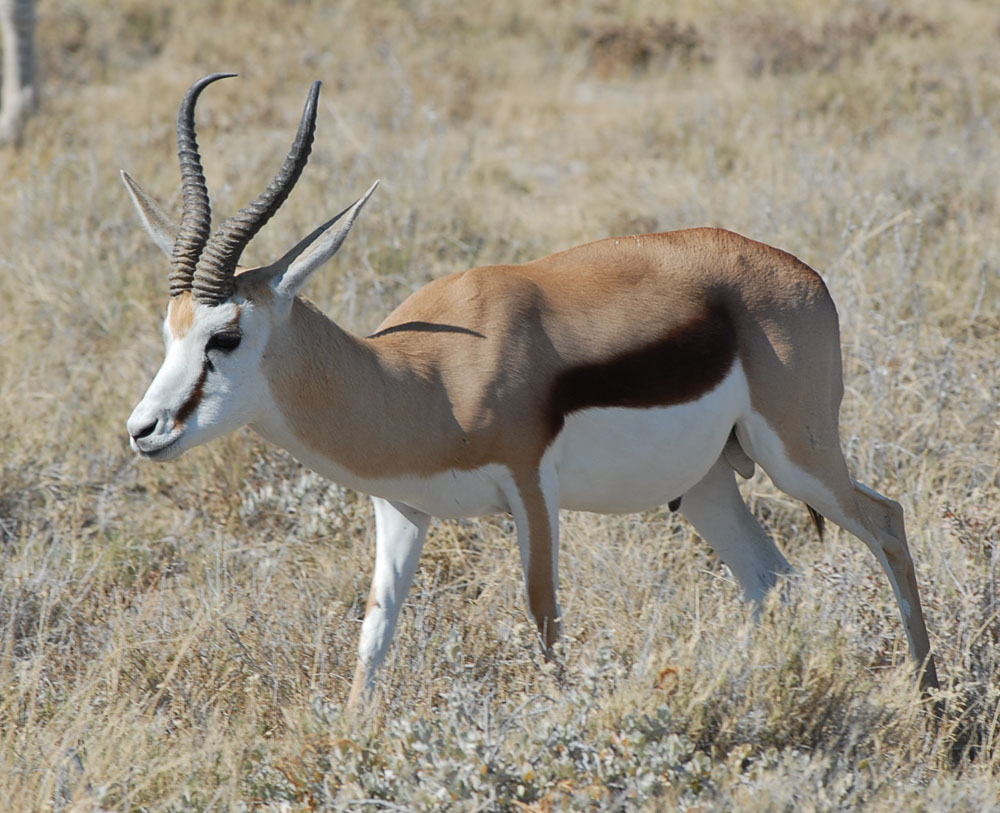
Here is a springbok. These are probably the most common Namibian ungulates, but I took very few photos of them.
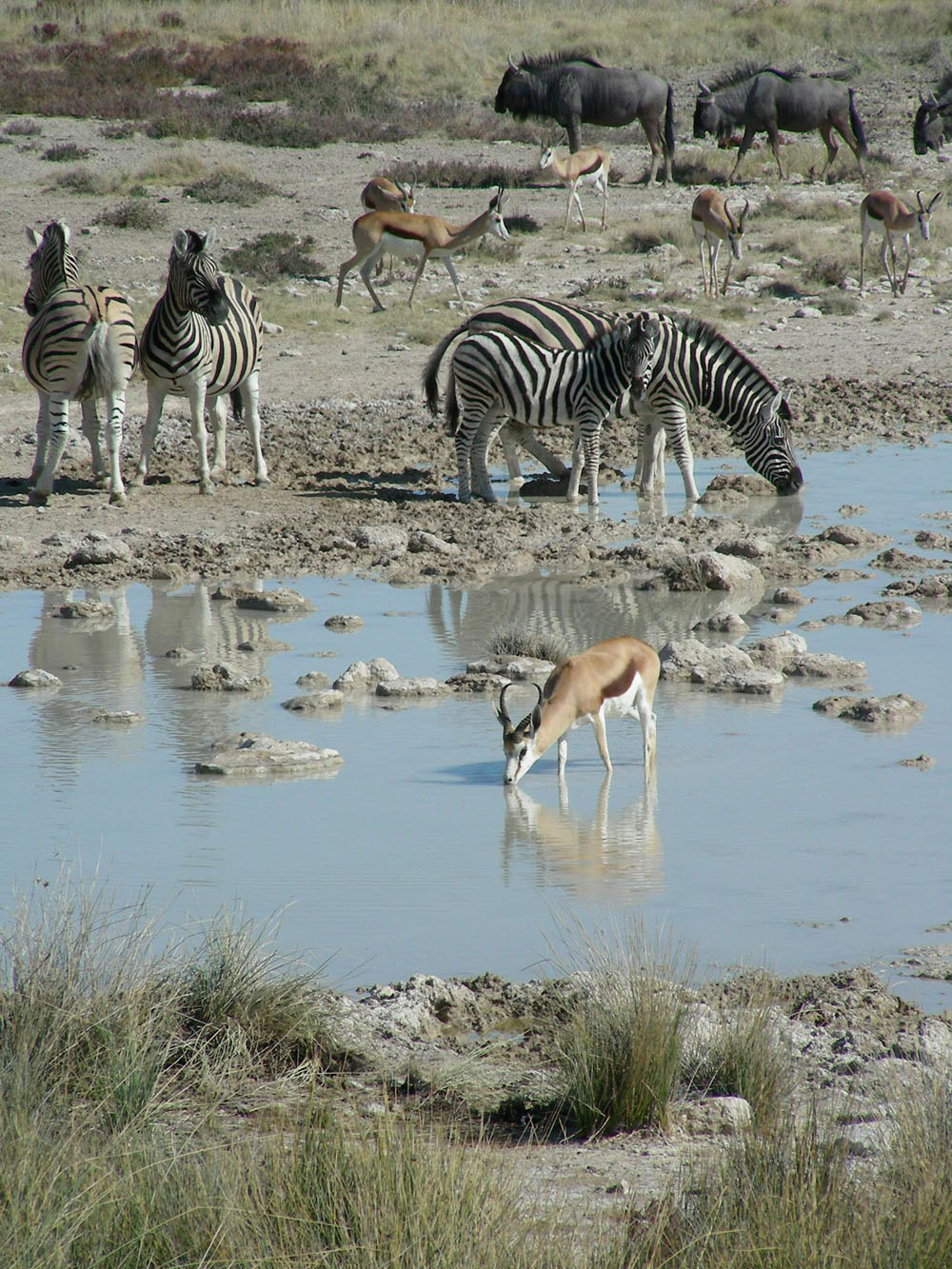
A species diverse waterhole...

And this waterhole had very few animals at it - only this one male lion that had a little bit of blood on its front legs...
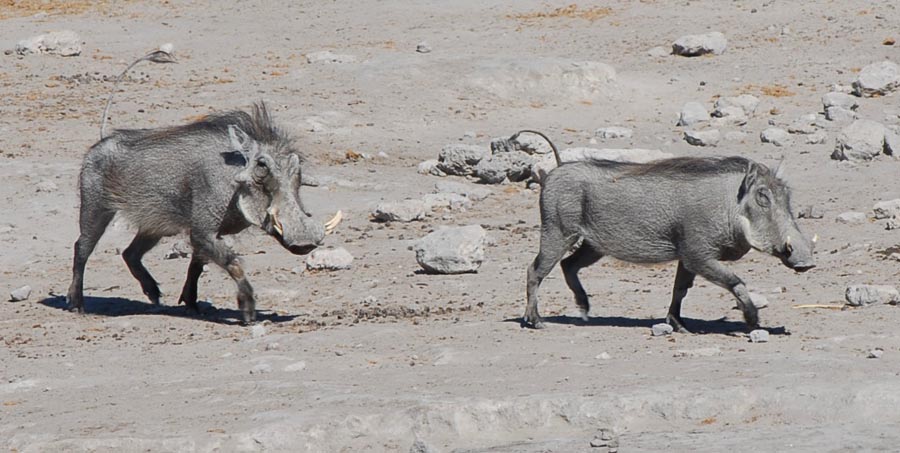
Warthogs